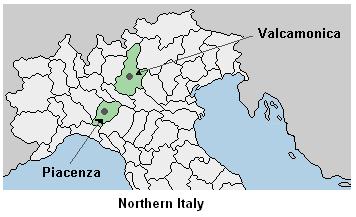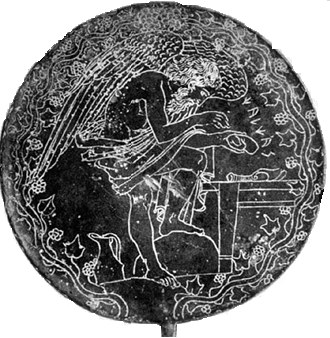|
It was
mentioned before, in Chaper 6 Universal Symbols, that a
group of tribes entered north Italy as early as 4,000 BP and
settled in the region of Valcamonica. These were the early
Asiatic (Uighur) Tur-Ok tribes that came to be later
known as the Etruscans. The whole region has been occupied by
these people and many artifacts, some containing inscriptions,
have been found and identified as being Etruscan. One such
interesting article, which gave rise to many speculations, is
the Piacenza inscribed piece of bronze.

The Piacenza bronze artifact (below) has the form of a liver
and because of this shape it has been defined as a divinatory
article. But the protuberances on the bronze artifact were
done on purpose and there is no sheep liver that has such
protuberances. Divination was the main activity performed by
the Etruscan shaman in ancient times. But, in my opinion, the
artifact is a map of the region with the names of different
tribes written in the Etruscan alphabet
(1).

The protuberances, done on purpose, are the mountains and
hills of the region. This is quite logical when we consider
that Piacenza is a city located on the south side of the Alp
Mountains, surrounded by hills. At the center above we see the
Etruscan inscriptions which are still not deciphered. There is
a borderline at the edge of the bronze artifact and several
words are carved around a small circle. Each word is clearly
separated by borderlines, clear indications of local regions
where different Ok tribes have settled. I have selected three
short words as examples to substantiate my claim. These words
are read from right to left according to a spelling method
developed by Kazim Mirþan
(2).
K.
Mirþan claimed that each letter in the Etruscan alphabet is a
monosyllabic root word, originating from the Proto-language
(see Chapter 1). Therefore, an Etruscan “word” is made out of
several concatenated monosyllabic meaningful root syllables /
words. They are written (carved) from right to left, as on the
ancient Turkish stone inscriptions of Central Asia. The top
word above can be read as Ok-Utch-On-Us and means “We
are the universal leader Ok tribe”. The first sign on the
right of the word is an arrow on the top word and a cross on
the middle word. This is because the Ok tribes represented
their names as both arrows and daggers.
Utch is
a Turkish word meaning “tip” and is pronounced as “udj”. The
ancient form of this root word is an inverted E. Notice the
form of this word having three extensions and the word for the
number three in Turkish, which is
ütch. The
three protuberances on the bronze artifact may also be a
symbolic indication of these leader tribes. A further clue to
support this claim is the name of the Turkish tribes known as
Üç
Oðuz
or Uçokuz, meaning “we are the three Ok tribes” or
equivalently “we are the leader Ok tribes”.
The second word above Ok-Ul-Us-Un can be read either as
Ok ulusun, which means “(region) belonging to
the Ok nation” or equivalently as
Ok Ulu-sun
“you are the sacred Ok” in Turkish. There are two words on the
third line. These can be read as
Uç-Us Sa-Ka, meaning
“we are the leader Saka (Scythian) tribe” (see Chapter 4,
The Asiatic Scythians).
This early
form of writing has later on evolved to represent words as we
understand today. But, when this method of reading is not
applied it is quite impossible to decipher the Etruscan
language. Being an agglutinative language, Etruscan with these
special characteristics should be compared to the Ural-Altaic
languages and especially to Turkish.

Another
Etruscan inscribed artifact is the rear side of a mirror shown
on the left. We see a winged man examining the internal organs
of a sacrificed animal (3). His name is read from left to
right as Chalcas, but almost all Etruscan inscriptions and
names are written from right to left. So, this name also
should be read from right to left. In that case we find a
meaningful Altaic word, which is: Saclach. In Turkish
saklý means “hidden” and
aç (ach) means
“open”. When these two words come together we find saklý-ach
or saklach meaning “open what is hidden”. The winged person in
that case becomes a soothsayer or a shaman performing
divinations. His wings indicate that he can perform mystical
flights into the unknown.
If Chalkas
is a proper name it should have a meaning because names
without any meaning were never used. Nobody knows the meaning
of Chalkas but the meaning of Saklach is perfectly fitted to
the visual picture. Below we see in the boxes the word read in
either direction. We see that the phoneme “tche” was written
in three different forms in both Etruscan as well as in the
ancient Turkish inscriptions of the Orhun valley. The
interesting point to note is that all forms contain three
extremities. These characters could be read as “utch”, “itch”,
“eutch” or “ytch” according to vowel harmony.

The correlation between the Orhun characters and the Etruscan
alphabet goes far beyond this single example. Every letter
being a seal contains a concept that needs to be explained in
detail. This will be done in the future chapters. |